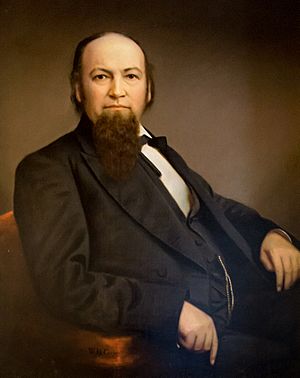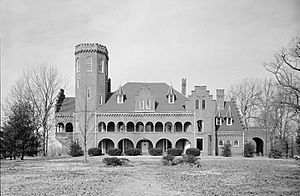Albert S. Marks facts for kids
Quick facts for kids
Albert Smith Marks
|
|
|---|---|

Portrait of Marks by Washington B. Cooper
|
|
| 21st Governor of Tennessee | |
| In office February 16, 1879 – January 17, 1881 |
|
| Preceded by | James D. Porter |
| Succeeded by | Alvin Hawkins |
| Personal details | |
| Born | October 16, 1836 Owensboro, Kentucky |
| Died | November 4, 1891 (aged 55) Nashville, Tennessee |
| Resting place | Winchester City Cemetery, Winchester, Tennessee |
| Political party | Democratic |
| Spouse | Novella Davis (m. 1863) |
| Profession | Attorney |
| Signature | |
| Military service | |
| Allegiance | |
| Branch/service | |
| Years of service | 1861–1865 |
| Rank | |
| Commands | 17th Tennessee Infantry |
| Battles/wars | American Civil War • Camp Wildcat (1861) • Mill Springs (1862) • Munfordville (1862) • Stones River (1862) |
Albert Smith Marks (born October 16, 1836 – died November 4, 1891) was an American lawyer, soldier, and politician. He served as the 21st governor of Tennessee from 1879 to 1881. Before becoming governor, he was a judge in the state's chancery court. Marks fought for the Confederacy during the American Civil War. He was injured in battle, which led to part of his leg being removed.
Contents
Early Life and Education
Albert Smith Marks was born in Owensboro, Kentucky. He was one of seven children. His parents, Elisha and Elizabeth Marks, were very religious Methodists. They hoped Albert would become a minister. He went to school in Owensboro until he was 14. After his father passed away, Albert helped his mother on the family farm. Even though he didn't have much formal schooling after that, he loved to read. He read many books about history and old literature.
When he was 19, Marks moved to Winchester, Tennessee. He worked at a law firm owned by his mother's cousin, Arthur S. Colyar. Marks studied law with Colyar and became a lawyer in 1858. Their law firm was first called Colyar, Marks and Frizzell. After 1861, it became Colyar and Marks.
Service in the Civil War
Even though Albert Marks was a Southern Democrat, he did not support the idea of states leaving the Union (secession). In early 1861, he ran as a candidate who wanted to keep the Union together. He campaigned alongside his opponent, who later became governor Peter Turney. However, when the war began, Marks joined the Confederate Army.
He was chosen as captain of Company E, 17th Tennessee Infantry. This group was first led by Felix K. Zollicoffer. Marks fought in battles like Camp Wildcat (October 1861) and Mill Springs (January 1862) in Kentucky. After Zollicoffer died, the 17th Regiment joined General Bushrod Johnson's forces. In May 1862, Marks was promoted to major.
In June 1862, Marks was promoted to colonel and took command of the 17th Regiment. His regiment was part of General Simon B. Buckner's division. This division attacked Kentucky in the fall of 1862. Marks's regiment fought at the Battle of Munfordville. There, General Buckner chose Marks to accept the official surrender of Union soldiers.
Later, the 17th Regiment joined General Patrick Cleburne's division. They fought at the Battle of Stones River on December 31, 1862. During this battle, Marks's regiment charged a Union cannon. A cannonball badly injured his right leg. Part of his leg had to be removed below the knee.
Marks spent most of the rest of the war recovering. He was in Winchester and a hospital in LaGrange, Georgia. Later, he joined General Nathan B. Forrest's staff as a legal advisor. After the war, he practiced law with Colyar in Winchester until 1866. Then, he started a new law firm with James Fitzpatrick and T.D. Gregory.
Becoming Governor
In 1870, Marks was elected as a judge for the state's Fourth Chancery District. He was reelected in 1878. However, he resigned after the Democratic Party chose him to run for governor that same year. In the election, he won easily. He received 89,958 votes. The Republican candidate, Eli Wight, received 42,284 votes. The Greenback candidate, Richard M. Edwards, received 14,155 votes. Marks was the first Democrat elected governor after the Civil War who had always been a Democrat.
Like the governors before him, Marks faced a big problem: the state's debt. Tennessee had borrowed a lot of money to build roads and railroads over many years. In 1873, a financial crisis (the Panic of 1873) caused property tax money to drop. The state could not pay its debts in 1875. Also, a Yellow Fever outbreak had badly affected Memphis, which put more stress on the economy. By the time Marks became governor, his party was split. Some wanted to pay back all the debt to protect the state's credit. Others wanted to pay back only part of it.
Marks created a committee in the legislature to study the debt problem. The committee found that some railroad agents had acted unfairly. They had tried to cheat the state. So, the committee suggested that the state should only pay back part of the debt. Marks agreed. A new plan was made with the banks. However, when this plan was put to a vote by the state's citizens, they rejected it. This left the debt problem unsolved.
Marks did not try to be reelected in 1880. He knew his party was still very divided over the debt issue. Because the Democrats were split, they lost the governor's election that year.
Later Life and Family
After his time as governor, Marks started a new law firm. It was called Colyar, Marks and Childress, with Colyar and John Childress, Jr. This firm worked until 1883. Marks stayed involved in politics. In 1888, he was an elector for the Democratic presidential candidates in Tennessee. He also attended the Democratic National Convention that year.
Marks passed away at the Maxwell House Hotel in Nashville on November 4, 1891. He was buried in the Winchester City Cemetery.
Marks married Novella Davis in 1863. This was while he was recovering from his war injury. They had been engaged before the Battle of Stones River. After his leg was removed, he offered to let her out of their engagement. But she refused. They had two children: Arthur Handly Marks and Albert Davis Marks.
Marks lived on a large farm near Winchester that he bought around 1870. In 1889, his son, Arthur, began building a huge house on this farm. It became known as Hundred Oaks Castle. After Arthur's death, his son, John, continued to expand it. The Catholic Paulist Fathers lived in Hundred Oaks for the first half of the 20th century. The house was added to the National Register of Historic Places in 1975. It is now cared for by the Kent Bramlett Foundation.
See also


